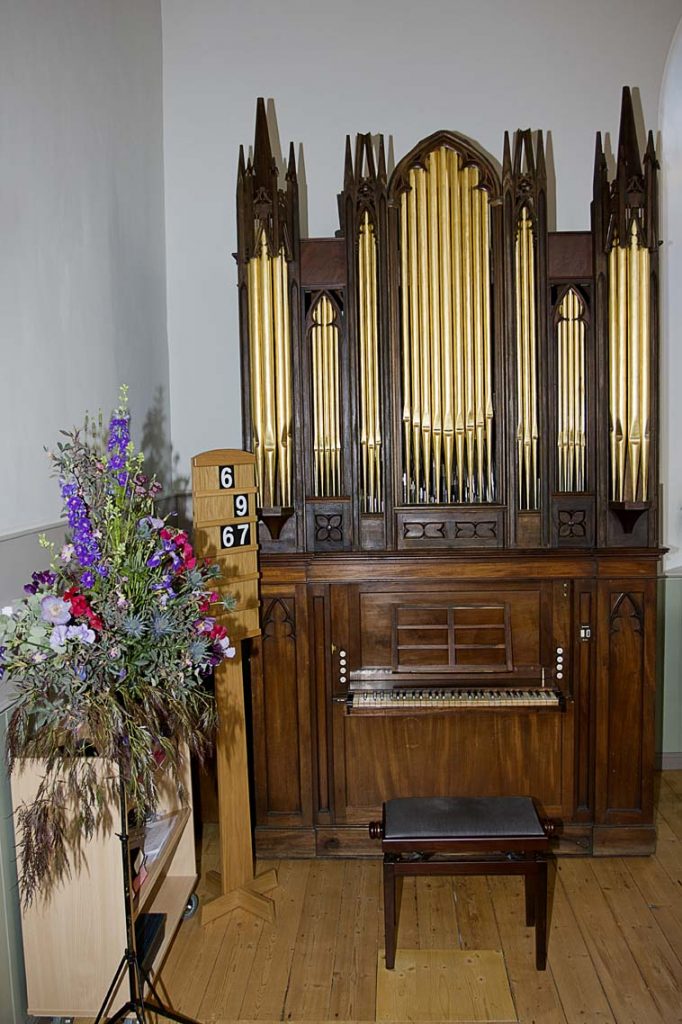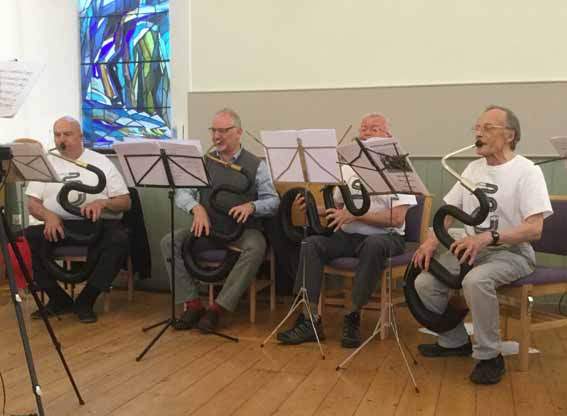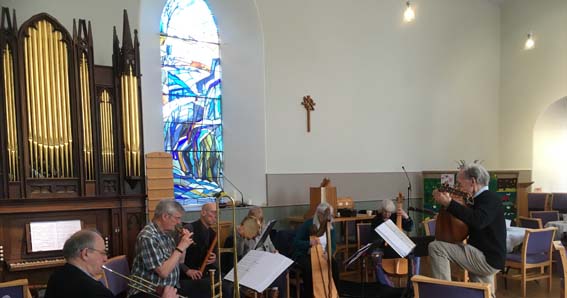Music plays an important part in the life of Carlops Church, both in church services, where sung praise features prominently and enjoyably, and also in concerts and recitals.
We are fortunate enough to possess a first class organ, built around 1820 by a prominent Scottish organ builder and recently restored. The organ’s performance is aided by our able and enthusiastic organist and by the church building’s excellent acoustic.
A high-quality Roland electronic keyboard, generously donated to Carlops Church in 2016, is used from time to time as an alternative accompaniment in worship and is also a valuable resource for musical performances.
Sung praise
Music is an important aspect of worship in Carlops, and the congregation includes many fine singers. There is a small choir, which from time to time adds a choral interlude to the Sunday morning service. Normally, however, the choir members are dispersed among the congregation, and the hymn singing (often in harmony) is a genuinely communal activity.
Traditional and well-known hymns are sung with great vigour, but the congregation is also enthusiastic and willing to explore new and unfamiliar songs of worship. We use the fourth edition of the Church hymnary (CH4).
Our organist loves the instrument and plays it with enviable skill and verve. Occasionally the organ is supplemented by other instruments. On Christmas Eve, the Carlops Orchestra squeezes into the space beside the organ, and the congregation joins in singing a new carol written every Christmas by the organist.
Our organ
Carlops Church is fortunate in having a fine example of an early nineteenth century chamber organ, almost certainly the work of the Scottish organ builder James Bruce. According to Alan Buchan, Curator of the Scottish Historic Organ Trust, it was probably constructed before 1820.
The organ has been in Carlops Church since 1968. It was obtained from the Secession Church in Arbroath (which was about to be demolished) for the cost of its transportation and rebuilding. Singing in Secession churches was normally led by a precentor, but in 1946, the Arbroath Secession congregation was given permission to install the organ, because no precentor was available. Before its 22 years in Arbroath, the organ served in the Kirk Memorial Congregational Church in Montgomery Street, Edinburgh, being gifted to that church by Mr Hunter, a former organist. Unfortunately, the date of his gift and all of the organ’s earlier history is lost and thus far, resists the efforts of our researchers! We welcome any information about our organ that readers of this page may have; if you can help, please contact us.

It is a single manual organ without pedals and it has an overall compass of five octaves from G1 to G6 (using the International Pitch Notation in which middle C is C4). There is no G#1 key. The organ has eight stops, three of which cover the entire compass; these are an 8′ Open Diapason, a 4′ Principal and a 2′ Fifteenth. The Stopped Diapason Bass covers G1- G3, while the Stopped Diapason Treble covers A3-G6. The remaining three stops are in a swell box operated by a foot pedal, and cover A3-G6: they are an 8′ Swell Dulciana, a 4′ Swell Flute and an 8′ Swell Hautboy. The organ is tuned to modern concert pitch (A4 = 440Hz).There were originally three foot-operated couplers, but these were missing when the organ came to Carlops. They were reconstructed when an extensive restoration of the organ was carried out by Sandy Edmonstone in 2008-09, as part of the general refurbishment. The original carved wooden case front had been seriously damaged, but this was also restored, and the dummy pipes lovingly re-gilded, by conservation students and local volunteers working under the supervision of Dr Patsy Campbell. The instrument is electrically blown, but the original hand-pumping lever is still in place and has been used occasionally during power cuts.
The organ is now in excellent playing condition and is an invaluable musical resource. Particularly attractive are the warm, flutey Stopped Diapason, the sparkling Fifteenth, and the pungent Hautboy.
The organ has ample power to support the singing of an enthusiastic congregation, even on Christmas Eve, when more than a hundred worshippers crowd into the little church to raise the roof with carol singing. It has also been used for organ recitals, and as an accompanying instrument in choral and chamber music concerts.
Concerts and recitals
Apart from serving its main function as a place for regular Christian worship, Carlops Church is an attractive venue for concerts. Several organists have given performances exploiting the resources of the Bruce organ, and song recitals have been very popular.
A number of larger scale concerts have also been given in the church; perhaps the most ambitious was a performance of Claudi Monteverdi’s Vespers of 1610 by the Linton Singers and the Scottish Gabrieli Ensemble.


The church’s acoustic
The main worship space in Carlops Church is essentially a rectangular box with a wooden floor and plastered walls and ceiling. There are 60 cushioned seats, but sound absorption has been minimised by leaving the floor uncarpeted. As a consequence, the space has a warm, lively acoustic, with a mid-frequency reverberation time of 1.5 seconds when empty.
This provides a comfortable environment for preaching and for lectures, although a modest amount of reinforcement is typically provided by the installed sound system. The natural acoustic of the space is ideal for chamber music performance and for encouraging congregational singing.
